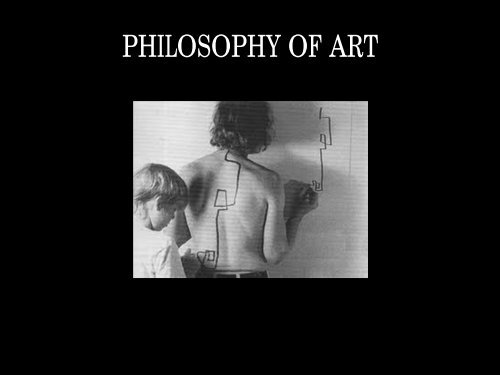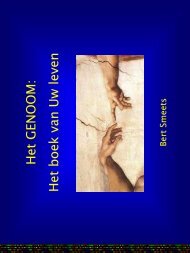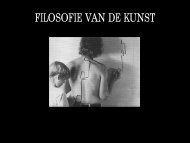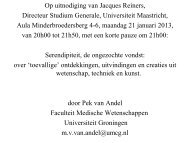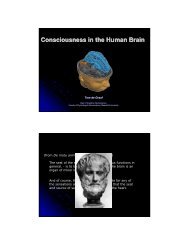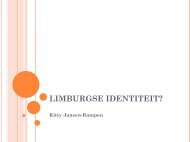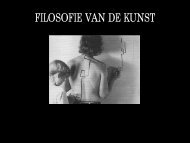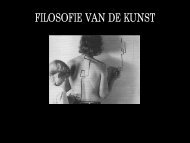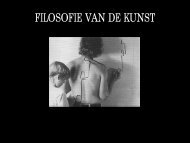PHILOSOPHY OF ART
PHILOSOPHY OF ART
PHILOSOPHY OF ART
Create successful ePaper yourself
Turn your PDF publications into a flip-book with our unique Google optimized e-Paper software.
<strong>PHILOSOPHY</strong> <strong>OF</strong> <strong>ART</strong>
LECTURES<br />
I. The Beauty and the Sublime.<br />
II. Ethics and Aesthetics.<br />
III. Nature and culture.<br />
IV. Aesthetic truth.<br />
V. Postmodernism.
I. THE BEAUTY AND THE SUBLIME
1. AESTHETICS<br />
What is art?<br />
2. THINK AND FEEL<br />
How to approach art?<br />
3. NOT ONLY BEAUTIFUL<br />
Is art only about the beauty?
I. AESTHETICS
TWO APPROACHES<br />
‣ Professional philosophers approach philosophy in<br />
two ways:<br />
1. An historical approach > the study of the<br />
history of ideas that philosophers<br />
developed.<br />
2. A systematic approach > the study of<br />
specific problems.<br />
‣ Aesthetics is like logic, ethics and metaphysics a<br />
subdiscipline of philosophy that can be<br />
approached in both ways.<br />
‣ Alexander Gottlieb Baumgarten (1714-1762) > the<br />
name giver of the subdiscipline aesthetics.
A CONTESTED DEMARCATION<br />
‣ In everyday life people often raise the question: what is art?<br />
‣ There are regularly public controversies about the demarcation<br />
between art and non-art.<br />
‣ The question ‘what is art?’ is often answered ex negativo > by<br />
indicating what art is not.<br />
‣ Several examples show that:<br />
- Music: the first performanc of the Altenberg Lieder<br />
composed by Alban Berg in 1913 > noise instead of music.<br />
- Literature: the publication of Lolita (1955) written by<br />
Vladimir<br />
Nabokov > porn instead of literature.<br />
- Visual arts: the exhibition of so-called ‘Degenerate Art’<br />
(Entartete Kunst (1937)) in Munich > false instead of true art.
BEYOND ESSENTIALISM<br />
‣ Many philosophers tried to discover the essence<br />
of art.<br />
‣ That was motivated by the question: ‘What is<br />
art?’<br />
‣ The presupposition > by carefully studying what<br />
art is its essence would be brought to light.<br />
‣ Especially modern art shows that this quest is<br />
vain > it is an illusion to think that the properties<br />
of an object make it a work of art.<br />
‣ That is what the Readymades of Marcel<br />
Duchamp show.
MARCEL DUCHAMP<br />
Short biography:<br />
‣ 1887: born January 4 in Balagnysur-Thérain.<br />
‣ 1912: initial study in Paris.<br />
‣ 1914-1919: was a soldier during<br />
World War I.<br />
‣ 1924-1928: close contact with the<br />
Surrealists.<br />
‣ 1941: emigration to the United<br />
States.<br />
‣ 1945: return to Paris.<br />
‣ 1968: died on October 2 in Neuilly.
<strong>ART</strong> ABOUT <strong>ART</strong><br />
‣ The revolutionary part of Duchamp’s<br />
art is that he brought up art for<br />
discussion.<br />
‣ In 1913 he did so by exhibiting a<br />
bicylce wheel (Roue de Bicyclette) that<br />
he had found (objet trouvé).<br />
‣ When he exhibited in 1917 a urinal<br />
titled Fountain and signed with<br />
R[ichard] Mutt it caused a shock.<br />
‣ Question: does the context determine<br />
whether something is art?<br />
‣ Readymades establish a kind of art<br />
about art.
WHEN<br />
‣Inspired by artists like Duchamp Nelson Goodman<br />
(1906-1998) in Ways of Worldmaking (1978)<br />
suggests to replace the question ‘what is art?’ by<br />
the question ‘when is art?’.<br />
‣It seems to be useful to examine when and under<br />
which circumstances an object receives the status<br />
of art.<br />
‣The when-question draws attention to the object<br />
and its context, but neglects the subject that<br />
perceives the object.<br />
‣New question: what is an aesthetic experience?
AESTHETIC EXPERIENCE<br />
‣A central question in contemporary aesthetics:<br />
what is the difference between an aesthetic<br />
experience and a non-aesthetic experience?<br />
‣Starting point: the experiences that a person<br />
gains from reading a novel, listening to a piece of<br />
music that moved him or her, or a painting that<br />
he or she likes are different from daily<br />
experiences.<br />
‣Before one addresses the issue of aesthetic<br />
experience one should deal with two<br />
philosophers that had an essentialist view of art.
PLATO (427-347 v. Chr.)<br />
Major works:<br />
‣The Parmenides.<br />
‣The Protagoras.<br />
‣The Timaeus.<br />
‣The Republic.<br />
‣The Laws.<br />
‣The Symposium.<br />
‣The Apology.<br />
‣The Phaedo.<br />
‣The Crito.
THE TRUTH AND THE BEAUTY<br />
‣ There are few philosophers who have sent so<br />
many contradictory messages about art as Plato.<br />
‣ On het one hand in The Symposium: “If there is<br />
anything that makes life worth living, then it is<br />
the contemplation about the beauty.”<br />
‣ On the other hand Plato argues in The Republic<br />
that art is incompatible with the process of<br />
establishing the truth.<br />
‣ Truth for him has nothing to do with<br />
correspondence, but with the ‘being’ of a thing.<br />
‣ A thing is more truth when it comes closer to an<br />
idea.
THE ESSENCE<br />
‣ The world of ideas is the true state of being > ideas are in time<br />
and space invariably and therefore the essence of everything.<br />
‣ The mortal and therefore the changing world is not really relevant<br />
> for Plato not the actual tulips, but the idea of the tulip is<br />
relevant.<br />
‣ Ideas are the archetypes of all that there is; they are the essence.<br />
‣ Plato distinguishes two types of artists:<br />
1. Those who create something > a blacksmith, cartwright<br />
or an architect.<br />
2. Those who express or imitate (mimesis) something > a<br />
painter, sculptor or poet.<br />
‣ The former are closer to the truth, because they have an idea in<br />
their mind that they try to realize.<br />
‣ The other artists don’t depict the being, but its appearance > they<br />
provide nothing more than a shadow of a dream.
SENSUAL PLEASURE IS DANGEROUS<br />
‣ The beauty arouses the desire to know ideas.<br />
‣ The idea of the beauty coincides with the idea<br />
of the truth.<br />
‣ Art can wake the desire to the highest value ><br />
the truth.<br />
‣ However, sometimes this desire is already<br />
satisfied when the appearance of the beauty is<br />
observed.<br />
‣ Because this sensual pleasure frustrates the<br />
process of establishing the truth, Plato is<br />
ultimately negative about art.
ARISTOTELES (384-324 v. Chr.)<br />
Major works:<br />
‣Categories.<br />
‣On Interpretation.<br />
‣Nicomachean Ethics.<br />
‣Politica.<br />
‣Poetics.<br />
‣Rhetoric.<br />
‣Physics.<br />
‣Metaphysics.<br />
‣On the Soul.
MIMESIS<br />
‣ Like Plato, Aristotle sees art as the expression or<br />
imitation (mimesis) of something.<br />
‣ However, Aristotle gives it a positive connotation.<br />
‣ That is because he rejects Plato’s notion of the<br />
truth.<br />
‣ According to Aristotle ideas don’t dwell in a<br />
separate world, but they are part of reality > they<br />
are housed in things and give shape to them.<br />
‣ Aristotle argues that it is the task of the artist not<br />
to copy reality one-to-one > they have “to say what<br />
really happened, but what could happen.”
THE GENERAL AND THE P<strong>ART</strong>ICULAR<br />
‣ Although tragedies depict historical figures, they<br />
always show how people in certain situations<br />
could act.<br />
‣ The purpose is not to express the particular but<br />
the general > the typical.<br />
‣ Therefore the poet is closer to the truth than the<br />
historian.<br />
‣ Artists should have the freedom not to copy<br />
reality blindly > it is all about the effects that a<br />
tragedy has on the spectators.<br />
‣ Effect is sorted when what is represented is<br />
credible.
PERFORMATIVITY<br />
‣ Art is according to Aristotle not only about the truth,<br />
but also about the effect.<br />
‣ Aristotle emphasizes, in other words, the<br />
performativity of works of art.<br />
‣ The tragedy evokes both pity and fear and thus ensures<br />
a pleasurable purification (katharsis) of these emotions.<br />
‣ For Plato art is odious because it evokes these kind of<br />
emotions.<br />
‣ Aristotle seeks a balance between reason and emotions<br />
> in certain circumstances it wouldn’t be reasonable if<br />
someone is not very angry.<br />
‣ It is for instance appropriate to be in the case of<br />
injustice angry.
II. THINK AND FEEL
IMMANUEL KANT (1724-1804)<br />
Major works:<br />
‣ Kritik der reinen Vernunft (1781).<br />
‣ Prolegomena (1783).<br />
‣ Grundlegung zur Metaphysik der<br />
Sitten (1785).<br />
‣ Kritik der praktischen Vernunft<br />
(1788).<br />
‣ Kritik der Urteilskraft (1783).<br />
‣ Zum ewigen Frieden (1795).<br />
‣ Die Metaphysik der Sitten (1797).
RATIONALISM AND EMPIRICISM<br />
‣ Due to Aristotle art was seen as rule-governed behaviour.<br />
‣ In the 17th century rationalism concluded that the beauty<br />
can ge generated if one apply certain rules.<br />
‣ In Engeland they struggled against an overly rational<br />
approach to art > there they presented an aesthetic view<br />
that does justice to what people feel (Shaftesbury,<br />
Hutcheson, Burke).<br />
‣ Empiricism > beautiful is what is perceived as such.<br />
‣ David Hume: the beauty is finally experiencing the pleasure<br />
one has when one observes an object.<br />
‣ Kant tries to bridge the gap between the two positions.
A DISINTERESTED WELL-BEING<br />
‣ The beauty is not linked to the object nor to the subject<br />
that observes.<br />
‣ Although pleasure is important when it comes to the<br />
aesthetic experience, it is not the same kind of pleasure<br />
that is evoked by the good or something that is just<br />
pleasant.<br />
‣ Something is good with regard to a predetermined goal and<br />
something is just pleasant, because it stimulates the senses<br />
in an unmediated positive way.<br />
‣ The pleasure of the beauty is a disinterested pleasure (ein<br />
interesseslose Wohlgefallen).<br />
‣ Because the aesthetic experience is free of interests, it<br />
transcends particular interests.
THE GENIUS<br />
‣ The beauty often arouses the desire of people to<br />
convince others about a specific aesthetic judgment.<br />
‣ Taste is relevant for the assessment of art.<br />
‣ For the creation of good art one needs the genius.<br />
‣ The genius > a person that creates and prescribes a new<br />
rule in art.<br />
‣ Unlike science art is not simply about the application of<br />
rules (methods).<br />
‣ The genius raises new standards.<br />
‣ Pablo Picasso is a good example, because he introduced<br />
new rules for painting.
Short biography:<br />
‣ 1881: born October in Malaga.<br />
PABLO PICASSO<br />
‣ 1891: first drawing lessons from his father.<br />
‣ 1895: starts to study at the art academy in<br />
Barcelona.<br />
‣ 1900: for the first time in Paris.<br />
‣ 1904-1908: stay in Paris where he meets<br />
among others Apollinaire, Matisse, Braque,<br />
Derain en Kahnweiler.<br />
‣ 1910: stay with Derain in Cadaqués.<br />
‣ 1911-1913: stay with Braque and Gris in Cérat.<br />
‣ 1925: participates in an exhibition of the<br />
surrealists.<br />
‣ 1973: died April 8 in Mougins.
CONSTRUCTIVISM<br />
‣ Picasso created several times a new visual<br />
language, i.e. rules for making images.<br />
‣ For instance, together with Juan Gris and<br />
George Braque he introduced Cubism.<br />
‣ The visual language of Cubism is indirectly<br />
influenced by Kant.<br />
‣ Not what is observed, but the<br />
construction of the person who perceives<br />
something from a specific angle is the<br />
starting point.<br />
‣ Cubist artists depict an object from<br />
different perspectives, analyses it and<br />
reassembles it by the construction of<br />
geometric forms > so one can do justice to<br />
the perception of a three-dimensional<br />
world on a two-dimensional canvas.<br />
• I
III. NOT ONLY BEAUTIFUL
BEYOND BEAUTY<br />
‣In the 18th and 19th century philosophers<br />
developed concepts that go beyond the beauty.<br />
‣They focus most often on two concepts: the ugly<br />
and the sublime.<br />
‣Karl Rosenranz (1805-1879) developed an<br />
aesthetics of the ugly > Ästhetik des Häßlichen<br />
(1853).<br />
‣Art that just wants to be beautiful, lapses easily<br />
into ornaments en limits its own possibilities of<br />
expression.
WHAT CANNOT BE GRASPED<br />
‣Edmund Burke (1729-1797) inspired Kant with his<br />
distinction of the beauty and the sublime.<br />
‣The sublime is an aesthetic quality that refers to the<br />
inconceivable of what is big.<br />
‣Whereas the beauty is about well-proportioned<br />
forms, the sublime refers to terrifying and irregular<br />
forms.<br />
‣The beauty > harmony between imagination and<br />
reason.<br />
‣The sublime > disharmony between imagination<br />
and reason.<br />
‣It is especially Barnett Newman that gives<br />
expression to that.
BARNETT NEWMAN<br />
Short biography:<br />
‣ 1905: born January 29 in New York.<br />
‣ 1922-1926: studies at Cornell University<br />
(Ithaca) and the Art Student’s League<br />
(New York).<br />
‣ 1927-1937: works at home with his<br />
parents.<br />
‣ 1948: establishes with William Baziotes,<br />
Robert Motherwell and Mark Rothko the<br />
art school ‘Subjects of the Artists’.<br />
‣ 1959: leads the ‘Artists Workshop’ of the<br />
de University of Saskatchewan.<br />
‣ 1962-1964: professor at the University of<br />
Pennsylvania.<br />
‣ 1970: died on June 4 in New York.
CONTRA FORMALIS<br />
‣ Newman opposes all kinds of formalism in<br />
art.<br />
‣ So he says the following about his famous<br />
Who’s afraid of Red, Yellow and Blue<br />
(1967/1968): “Just as I had confronted other<br />
dogmatic positions of the purists, neoplasticists<br />
and other formalists, I was now in<br />
confrontation with their dogma, which had<br />
reduced red, yellow and blue into an ideadidact,<br />
or at best had made them<br />
pittoresque. Why give in to these purists and<br />
formalists who have put a mortgage on red,<br />
yellow and blue, transforming these colors<br />
into an idea that destroys them as colors? I<br />
had therefore, the double incentive of using<br />
these colors to express what I wanted to do<br />
of making these colors expressive rather<br />
than didactic, and of freeing them form the<br />
mortgage. Why should anybody be afraid of<br />
red, yellow and blue? www.youtube.com/watch?v=2QnrXJghoU
JEAN-FRANÇOIS LYOTARD (1924-1998)<br />
MAJOR WORKS<br />
‣ La Phénomenologie (1954).<br />
‣ Discours, figure (1971).<br />
‣ Economie libidinale (1974).<br />
‣ Les transformations Duchamp (1977).<br />
‣ La condition postmoderne. Rapport sur<br />
le savoir (1979).<br />
‣ Le différend (1983).<br />
‣ Le postmoderne expliqué aux enfants<br />
(1986).<br />
‣ L 'inhumain. Causeries sur le temps<br />
(1988).<br />
‣ Leçons sur l'analytique du sublime.<br />
Kant, Critique de la faculté de juger<br />
(1991).
THE EVENT<br />
‣ The ‘now’ is sandwiched between what has<br />
happened and what is yet to come.<br />
‣ Lyotard wants to do justice to the event that is<br />
in between the not yet and the not-more.<br />
‣ His question: how can something be present?<br />
‣ This is a question of being and time and evokes<br />
another question: why is there something at<br />
all?<br />
‣ This is simply incomprehensible, something<br />
that one cannot grasp.
THE POWER <strong>OF</strong> THE INTANGIBLE<br />
‣ Art can let one feel what is intangible, what one<br />
cannot grasp.<br />
‣ Lyotard argues that that is the task of art.<br />
‣ The sublime, according to him, is the evocation of<br />
the present time and what cannot be grasped with<br />
language.<br />
‣ Just when one tries to express it in words, it<br />
vanishes.<br />
‣ Lyotard refers to an essay of Barnet Newman: The<br />
Sublime is Now (1948).<br />
‣ He argues: “That here and now there is an image,<br />
than rather nothing, that is the sublime”.
To see:<br />
RECOMMENDATIONS<br />
‣ Marcel Duchamp ><br />
http://www.youtube.com/watch?v=7Cuqni9rqHw<br />
‣ Pablo Picasso ><br />
http://www.youtube.com/watch?v=Pjlq85R_mcQ&feature<br />
=endscreen<br />
‣ Barnett Newman ><br />
http://www.youtube.com/watch?v=2Qn-rXJghoU<br />
To read:<br />
‣ Plato > The Symposium.<br />
‣ Immanuel Kant > Critique of Judgment (1783).<br />
‣ Nelson Goodman > Ways of Worldmaking (1978).


